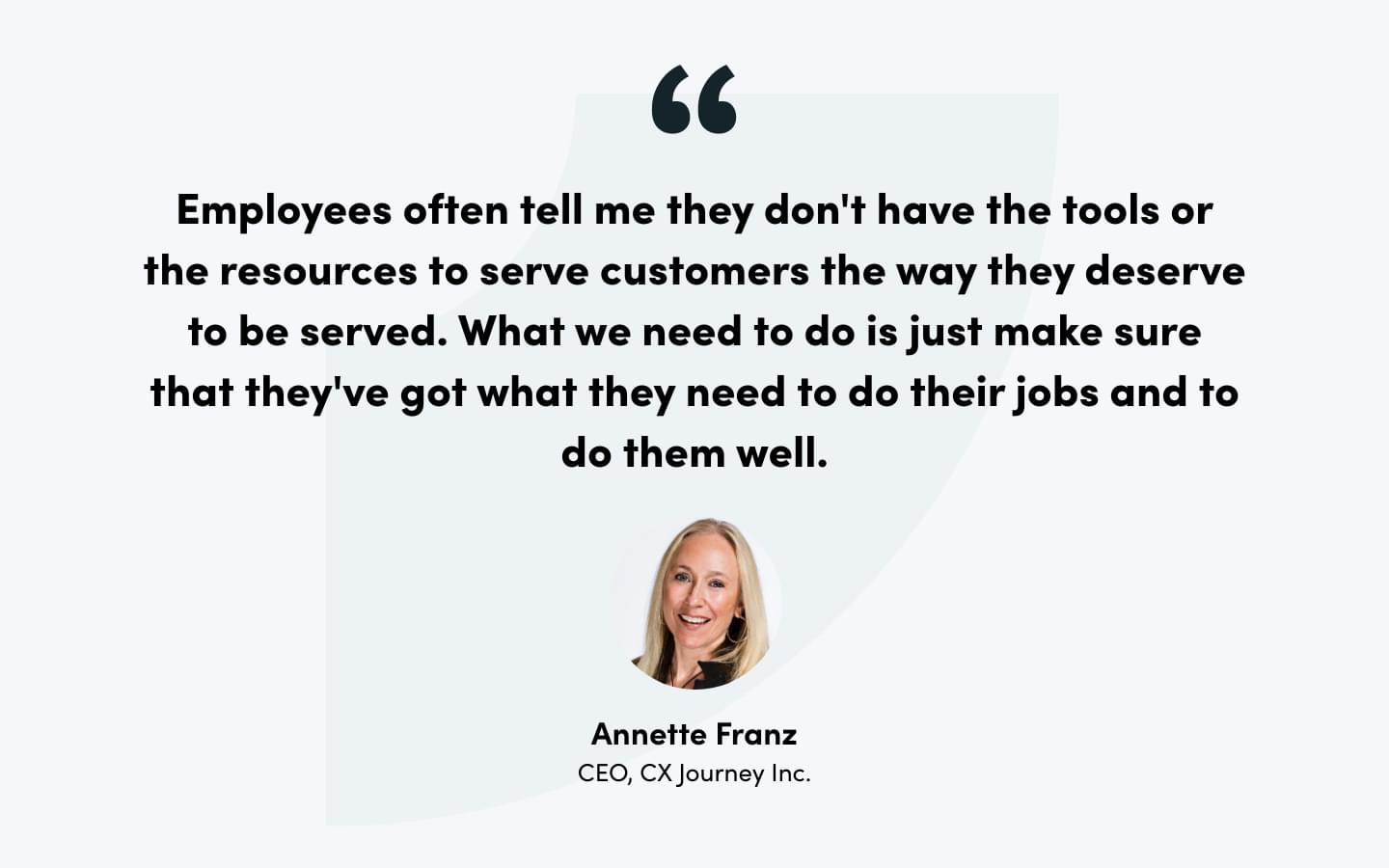Employees drive the customer experience.
According to CX leader Annette Franz, there are a few words missing in that sentence. Let’s try again.
The employee experience drives the customer experience.
There we go; that’s better!
We invited Annette onto our Practically Genius podcast to break down this concept in detail. Early on in the episode, she mentioned how many companies miss the CX mark because they are “not focusing on the employee experience and making that connection between the employees and how they drive the customer experience. We need to make sure that our employees are taken care of.”
The founder and CEO of CX Journey Inc. has more than 30 years of experience building, auditing, and improving customer experiences across organizations of all sizes, industries, and locations. She’s seen firsthand how a poor employee experience negatively impacts the customer experience.
Because of this, she also knows which aspects of the employee experience directly impact the customer experience. Here are three areas she suggests organizations focus on.

Listen Now: If you’re passionate about customer experience, you need to hear all of Annette’s advice. Listen to her episode The Truth about NPS and Getting Customer Experience Right!
Invest in People
Annette’s point of view is more relevant than ever because of the current state of hiring, high employee burnout, and turbulent markets. “I think we have seen many examples of this over the last year with the Great Resignation, where companies don't have enough people, so the experience is awful,” she said. “Or they have people, and they're frustrated because the working conditions, culture, and pay are just frustrating them like crazy. The customer ends up suffering from that as well.”
She made it clear that if you don’t support and invest in your employees, you’re likely failing customers. She went on to explain that developing a strong customer experience requires investing in people and providing them the resources necessary to do their job well.
What does she mean by investing in people? It goes well beyond simply having enough hands on deck. Here are a few things to consider:
- Adequately staffing all departments by hiring the right people quickly
- Providing teams enough budget for necessary resources
- Offering strong pay, benefits, and work-life balance
- Empowering employees to bring forth ideas and change
- Building out career paths and opportunities for growth
- Training employees often on new processes, tools, and best practices
When you invest in employees across all areas of the employee experience, customers will reap the benefits.
But don’t just take it from us. A Harvard Business Review article points out that there is strong statistical evidence tying employee well-being to customer satisfaction. They specifically highlight a report by Glassdoor that shows a clear link between employee and customer satisfaction.
Investing in people starts by hiring the right ones. Check out these resources for help:
Hiring Hidden Gems: How Do You Uncover the Best Talent?
Candidate Experience Matters: 3 Practical Tips for Successful Hiring
How to Improve Your Hiring Process and Win the War for Talent
Audit and Fix Processes
You may have employees who are incredibly dedicated to serving customers but can’t because of broken systems and inefficient processes. This can cause delays in service, disruptions in communication, and many other frustrating moments for customers.
Annette pointed out that when things go wrong on the inside, they have a massive effect on the outside:
These issues could be caused by process debt or a lack of digital maturity, but regardless, there are some ways to ensure processes don’t derail the customer experience.
Build systems that put the customer first.
Set your CX team up for success by creating systems that are flexible. There must be guidelines and best practices in place, but being able to flex according to a customer’s unique wants, needs, and issues can greatly contribute to business success. It’s highly unlikely that a process will work perfectly every time for every customer; building in flexibility empowers your employees to make smart decisions that serve the customer best.
Audit processes to identify inefficiencies.
Don’t just set it and forget it forever. Customers want to be served quickly, especially in the age of contactless service and digital experiences. To ensure efficiency and speed of service, audit processes on a regular basis. This is an excellent way to identify and fix bottlenecks, miscommunication, and inefficiencies before they become an overwhelming problem for employees and customers.
Update policies on a consistent basis.
Is red tape keeping your employees from fulfilling the needs of customers? What might have worked a few years ago may not be the best fit for employees or customers anymore. Don’t let policies gather dust and decay—adjust them as needed to address changes in technology, customer trends, and market changes.

Provide More Resources
A lack of resources is one of the most common issues Annette sees across her clients. “When I first start working with clients, I interview employees, executives, and customers. Employees often tell me they don't have the tools or the resources to serve customers the way they deserve to be served,” she stated. “What we need to do is just make sure that they've got what they need to do their jobs and to do them well.”

The resources Annette sees organizations lacking include:
- Employees
- Technology
- Training
- Budget
- Time
- Processes
Identifying where your organization lacks resources doesn’t have to be an overly complicated or drawn-out process.
First, speak with employees. Offer a variety of ways for employees to provide thoughts, feedback, and suggestions on what they need to get their job done. This will reveal pain points; blockers; and what teams, roles, or departments lack the most resources. You can collect this feedback in a variety of ways, including focus groups, anonymous surveys, team meetings, annual reviews, and town-hall discussions.
Second, take a look at any data available to you. Is turnover high? Do any processes experience frequent bottlenecks? Are projects often getting delayed or pushed to the back burner? Reviewing data from your operations teams across departments can help you better identify issues and potential fixes.
Read Next: Discover how to gather buy-in for your next big project.
Improving the Customer Experience Starts with Employees
It’s pretty clear that improving the customer experience isn’t just the CX team’s job. It’s everyone's responsibility. But no team can successfully serve customers without the right people, processes, and tools in place. When you provide employees the resources they need, you’ll see just how much improving the employee experience impacts customers.
Annette provides even more great advice on how to improve the customer experience in the Practically Genius podcast episode The Truth about NPS and Getting Customer Experience Right!











